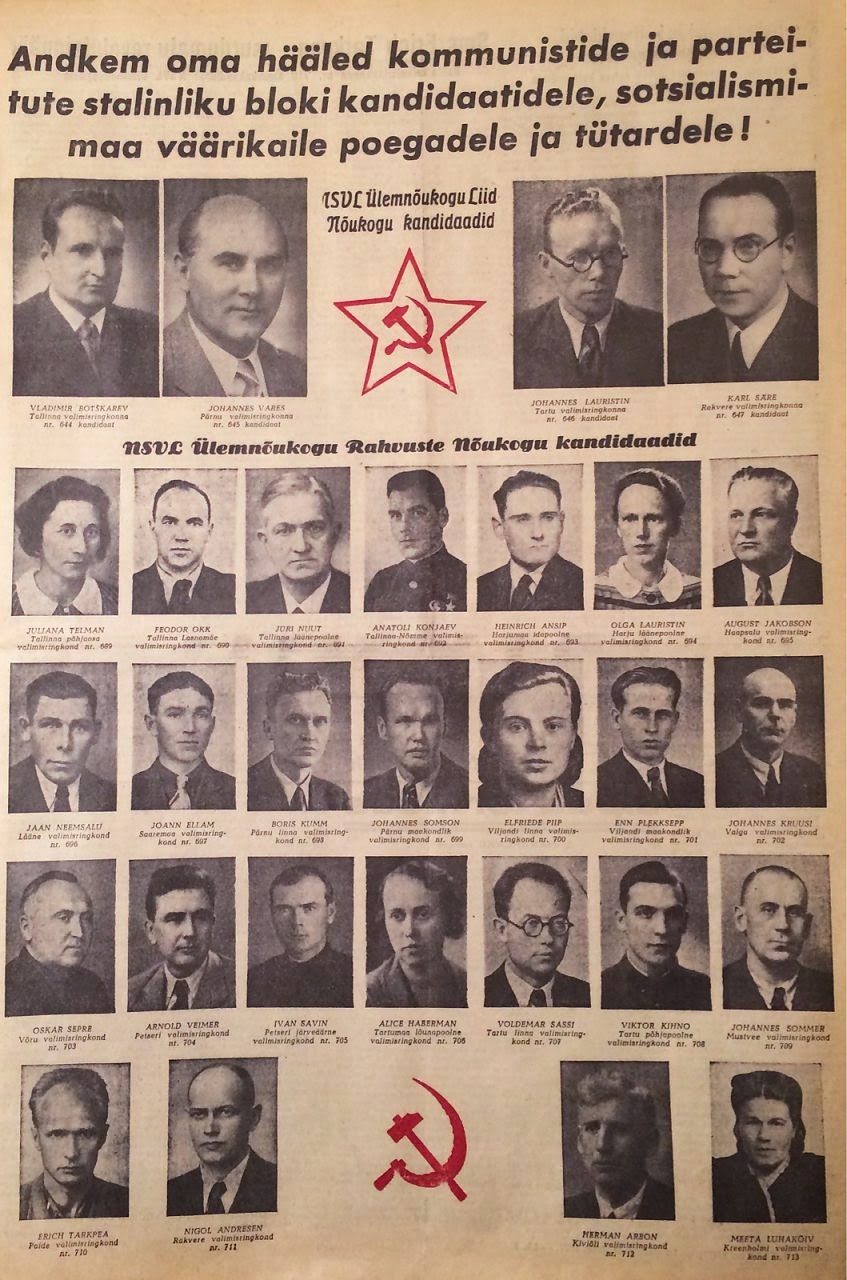triumphant return of delegation that went to moscow, to beg incorporation of estonia into the USSR
Juliana Telman, Olga & Johannes Lauristin, Neeme Ruus.
Maksim Unt & Orest Kärm, left. blond, aryan in between, Erich Tarkpea.
Nadežda Tihonova, Johannes Lauristin, Paul Keerdo, Johannes Vares, Karl Säre and Neeme Ruus
jewish guy, second left, Jossif Goldmann.
jewish guy, second left, Jossif Goldmann.
chairman of parlament, Arnold Veimer
on the roof of hotell Moskva
prime-minister of estonian SSR Johannes Vares-Barbarus and its foreign minister Nigol Andresen
historian Hans Kruus was deputy prime-minister in Vares cabinet.
tearing down the estonian flag. 'TALL HERMANN' tower Tallinn 21.06.1940
by Edgar Petree, Karl Leesik, Aleksander Resev and unknown persons in bright casket and top hat.
pro-soviet demo in early days, still under national flag.
summer 1940. athlets demand estonia to become part of ussr
Gala dedicated to XXII anniversary of russia's bolshevik revolution in Estonia
Tallinn, 7th nov. 39. choir most probably delivers 'international'
Candidates of the first, under stalin, elections (12.1.1941). "noorte hääl", december 1940.
( zoom for the names.)
estonian NKVD people. boris kumm in center, idel jakobson, leftmost,
v.riis nearest right
segei kingissepp
notorious NKVD interrogator,lost his life in sea, during evacuation in last days of august 41
idel jakobson
his deputy.police mugshote.
v.riis nearest right
segei kingissepp
notorious NKVD interrogator,lost his life in sea, during evacuation in last days of august 41
idel jakobson
his deputy.police mugshote.
minister of interior in earlydays of ESSR, Maksim Unt
was executed for unknown reason in july 1941.
Commissioner of the Interior Affairs of the ESSR,
Andrei Murro.
seems, lost his life during evacuation of tallinn in last days of august 41
carl säre
was assigned for underground work in estonia, was apprehended in the first days, germans took
tallinn. he was interrogated in various places. traces of him lost after 43.
Vastupidiselt kohalikele aktivistidele oli ENSV tippkommunistidele ülisalajase operatsiooni eesmärk teada ning nad kuulusid kuritegeliku kolmiku ehk nn troika koosseisu, vastutades ülesande täitmise eest. ENSV tippkolmiku koosseisu kuulusid kompartei I sekretär Karl Säre, riikliku julgeoleku rahvakomissar Boris Kumm ja siseasjade rahvakomissar Andrei Murro. Igas maakonnas olid oma kolmikud. Näiteks Pärnumaalt on teada: maakonna troika esimees NKGB ülem Kikkas ja liikmed NKVD kohalik ülem Johan Tamm ning Pärnumaa NKGB ülema asetäitja Gnezdin.
Kult& Elu
Vastupidiselt kohalikele aktivistidele oli ENSV tippkommunistidele ülisalajase operatsiooni eesmärk teada ning nad kuulusid kuritegeliku kolmiku ehk nn troika koosseisu, vastutades ülesande täitmise eest. ENSV tippkolmiku koosseisu kuulusid kompartei I sekretär Karl Säre, riikliku julgeoleku rahvakomissar Boris Kumm ja siseasjade rahvakomissar Andrei Murro. Igas maakonnas olid oma kolmikud. Näiteks Pärnumaalt on teada: maakonna troika esimees NKGB ülem Kikkas ja liikmed NKVD kohalik ülem Johan Tamm ning Pärnumaa NKGB ülema asetäitja Gnezdin.
Kult& Elu
The mass deportation from Estonia
was directed by the troika including People’s State
Security Commissioner of the Estonian SSR, Boris Kumm,
People’s Commissioner of the Interior Affairs of the ESSR,
Andrei Murro and First Secretary of the Estonian
Communist Party (Bolsheviks), Karl Säre.
in kremlin, aug. 1940
in nearest row; Ruus, Lauristin, Vares
jubilant crowd meet 'beggars' delegation on their arrival from moscow .
the same in latvia
riga
Top row: Minister-President A.Kirhenshteyn, Minister of War gene. R.Dambit Interior Minister V.Latsis Comrade. Interior Minister V.Latkovsky. Bottom row: Minister of Public Affairs P.Blau, minister of public welfare Yu.Latsic Justice Minister Yu.Paberz, Minister of Posts Ya.Yagars.
Top row: Minister-President A.Kirhenshteyn, Minister of War gene. R.Dambit Interior Minister V.Latsis Comrade. Interior Minister V.Latkovsky. Bottom row: Minister of Public Affairs P.Blau, minister of public welfare Yu.Latsic Justice Minister Yu.Paberz, Minister of Posts Ya.Yagars.
and lithuania
Justas Paleckis speaks to masses. short individual next to him, Dekanozov.
TALLINN 28 aug 41, the end of 1st soviet occupation and beginning of nazi's
pics are from Oskar Viikholm collection and EFA archive.
TALLINN 28 aug 41, the end of 1st soviet occupation and beginning of nazi's
pics are from Oskar Viikholm collection and EFA archive.

































